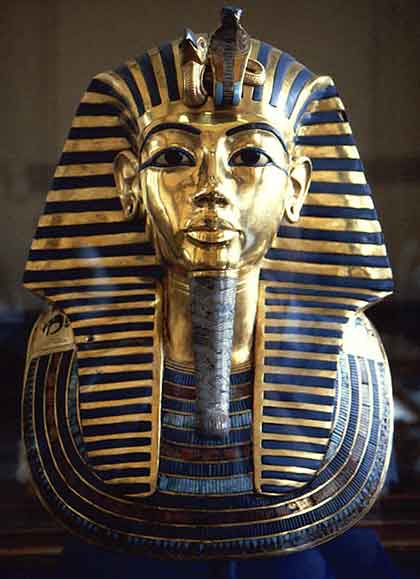Birthstones by the Month
One of The December Birthstones is Turquoise
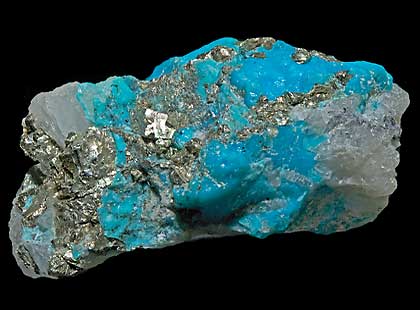
Crystals of turquoise
Crystals of turquoise, pyrite and quartz in this piece from the Sleeping Beauty Mine. [3]
Turquoise Mineral Form
The hugely popular gemstone Turquoise is a copper aluminium phosphate. Turquoise is a hydrous mineral, meaning water is an important element. The typical colors of Turquoise are caused by copper (blue) and bivalent iron plus chrome (green). Turquoise does not form in perfect crystals, instead showing up as an aggregate of microcrystals.
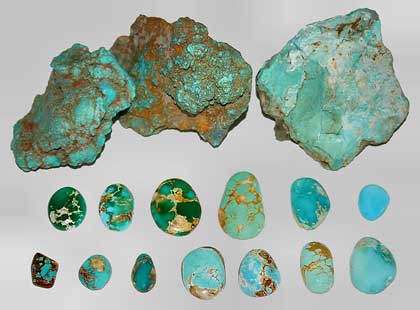
Various Turquoise Cabochons
Various type of Turquoise. This lot of cabochons and rough stone show off the different blues and aquas turquoise can produce. [2]
Turquoise Facts
Typically Turquoise has a waxy luster and can have matrix throughout. Matrix is a remnant of the “host” rock from which Turquoise formed. Turquoise is formed in arid climates where rainfall filters through soil and rock causing copper to dissolve. When the water evaporates, copper combines with the aluminum and phosphorus in tiny deposits. Matrix, lined patterns typically black or brown, forms when the Turquoise does not completely replace the host rock in a solid mass. These web-like lines can be deemed valuable depending on the mined region. Turquoise has been found across the globe, aiding in its use throughout history in religion, art, trade and more. Most typically, Turquoise is mined in the USA, China, Mexico, Afghanistan, Israel and Iran.
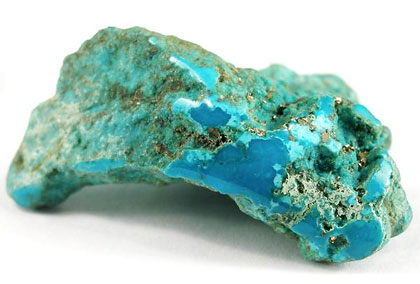
Sky-blue Turquoise
Turquoise from this uncommon Mexican locale - the La Mariquita Mine in Sonora. One edge has been partially polished to reveal the gorgeous, sky-blue color. Weighs 31 grams. [1]
The characteristics of Turquoise
Each region Turquoise is found in produces different colors of the gemstone. Some notable color differences include the highly prized sky blue Sleeping Beauty turquoise from Arizona that has no matrix to the rougher, organic-looking yellow Turquoise with heavy matrix found in Africa. Turquoise has perfect cleavage, meaning the cleavage occurs along a perfectly smooth plane. Turquoise is described as waxy to subvitreous luster.
Cut and Clarity for the December birthstone
Turquoise is often cut to avoid matrix, though there are varieties of the stone where that is suboptimal and some buyers prefer the look of matrix. The clarity of Turquoise is opaque, so it’s less likely to see internal inclusions with this gemstone.
The value of Turquoise
While matrix is appreciated by many buyers, the value of turquoise does go up when there is no matrix present. Turquoise has been highly revered and valued throughout history in many countries and continues to hold a place of esteem amongst many gem collectors and dealers. One of the most valued Turquoise varieties is the Sleeping Beauty Turquoise with a pure, sky blue color free of matrix. Turquoise with more green color and blotchy or irregular matrix reduces in value. There are far more green gems than natural blue minerals causing the bluer Turquoise to capture more attention in gemstone markets. /p>
Is Turquoise ever treated?
Turquoise can receive a number of treatments depending on surface texture and color. To improve overall even color, some Turquoise is dyed. Other Turquoise is stabilized to improve the strength and polished appearance. Since Turquoise is a hydrous stone, even high-quality varieties are often waxed to preserve internal integrity and reduce potential color wear as the stone ages.
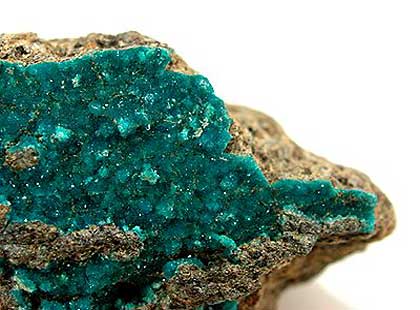
Turquoise Crystals
Crystallized turquoise is for some reason a true rarity in nature and occurs only at a few locations worldwide.[5]
More about Turquoise the December birthstone
Because Turquoise can alter color if too much water is lost, it’s actually not a bad idea to “water” your Turquoise with pure saline water as long as it is not in a setting moisture can damage. Wearing Turquoise often will also help keep the color vivid thanks to natural skin oils. Turquoise is porous though, so sweat, chlorine, detergents and other chemicals can cause the gem to fade and it is unwise to clean Turquoise in anything other than non-chlorinated and salt-free water. Varieties of Turquoise have also been known to fade if left exposed to direct sunlight for long periods of time. Turquoise has a medium Mohs hardness at about 5 to 6 on the scale so the gem should not be stored with harder materials that could potentially damage the surface.
The American Gem Society's December Birthstone page has more information to help you buy from knowledgeable and skilled jewelers and to help you make the most informed buying decision.
Image Attribution
- Rob Lavinsky, iRocks.com – CC-BY-SA-3.0 [CC BY-SA 3.0], via Wikimedia Commons
- By Turq_mcGuin_bunker.jpg:Reno Chris at en.wikipediaderivative work: Ra'ike T C (Turq_mcGuin_bunker.jpg) [Public domain], from Wikimedia Commons
- By Parent Géry (Own work) [CC BY-SA 3.0], via Wikimedia Commons
- By Jon Bodsworth [Copyrighted free use], via Wikimedia Commons
- Rob Lavinsky, iRocks.com – CC-BY-SA-3.0 [CC BY-SA 3.0], via Wikimedia Commons
